Driving Homeowners ‘Nuts’: Sedge in the Lawn
ID
SPES-344NP
Introduction
Have you got grass-like patches that grow at least twice as fast as your turf during the summer, even during some of the hottest weather possible (Figure 1)? You likely are combating one of the many species of nutsedge or closely related plants, very common warm-season lawn weeds all across Virginia and the mid-Atlantic.
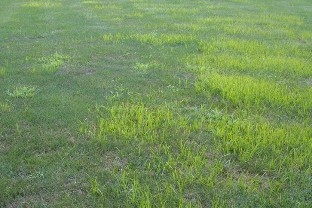
Identification characteristics and conditions that promote these weeds
Lots of questions come in to the offices of the VT Turf Team and those of our statewide Virginia Cooperative Extension network alike during the summer/early fall period regarding ‘grass-like patches that just can’t be mowed often enough’ (Figure 1). Probably 9 times out of 10, those ‘grass’ patches turn out to be patches of yellow nutsedge, a plant that is commonly referred to as ‘nutgrass’, but it is not in the grass family. The way to identify these plants is to remember the phrase ‘sedges have edges’ (Figure 2). Since these plants are not grasses, that affords us the opportunity for selective weed control in our lawns.
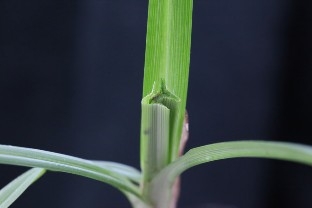
There are two primary species of nutsedges in Virginia lawns, with the most prevalent form being yellow nutsedge (Cyperus esculentus L., Figure 3). In the warmest parts of the state, purple nutsedge is added to the mix (Cyperus purpureum L.), Figure 3. Yellow and purple nutsedge come back in the spring from underground tubers that are about ¼ to ½ inch long.
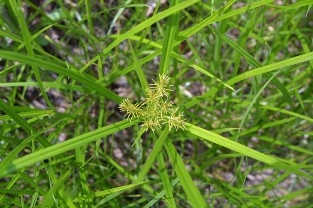
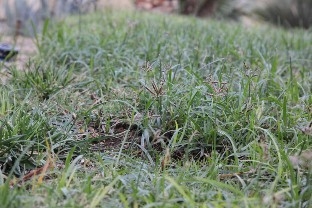
The color of the seedheads make distinguishing between yellow and purple nutsedge very easy. However, what if there are no seedheads present, as might occur in a regularly mowed turf? Carefully pulling these plants from the ground reveals that both have rhizomes (i.e. below-ground stems) that have nutlets (reproductive structures often called tubers) that are arranged differently on the rhizome depending on the sedge species. Yellow nutsedge produces its nutlet at the tip of the rhizome, whereas purple nutsedge produces its nutlets in chains along the rhizome (Figure 5).
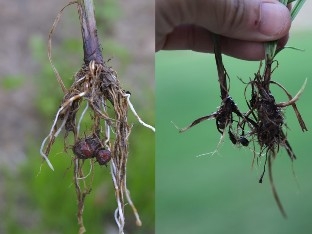
Two of the most rapidly expanding sedge-family weeds in mid-Atlantic landscapes are the closely related plants false-green kyllinga (Kyllinga gracillima Miq.) and perennial green kyllinga (Kyllinga brevifolia Rottb.). These plants form dense mats in turfgrass rather than distinct patches as is common for the sedges (Figure 6). The kyllingas are very difficult to tell apart because they are so similar in appearance, but they are much finer textured than the sedges and have a very distinct circular seedhead (Figure 7). In general, the mid-Atlantic has greater populations of false green kyllinga because of its superior cold tolerance, and this plant keeps migrating further north each year. These perennial members of the sedge family do not produce nutlets on their lateral stems.
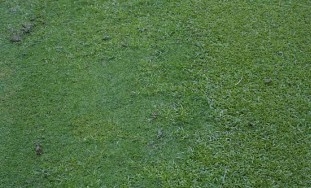
Sedges prefer warm temperatures, full sun, and higher soil moisture. Mowing at the higher recommended mowing heights will help to shade and thus suppress yellow nutsedge and other sedges. Do not over-water as this will increase sedge and kyllinga growth. Improve soil drainage if the soil does not drain well.

Control alternatives and application timing
There are four primary sprayable herbicides available for nutsedge control in the homeowner market. The active ingredients to look for on the herbicide label are: bentazon, halosulfuron, imazaquin, or sulfentrazone. Of this group, the most effective for controlling yellow nutsedge are sulfentrazone and halosulfuron, and these two herbicides are also used for controlling other sedge species, including kyllinga species. Imazaquin and bentazon have been staples for many years in targeting various sedge species but often require more frequent application. The newest herbicide for sedge control in turf is pyrimisulfan, sold in granular form and applied dry. The VCE Pest Management Guide for Home Grounds and Animals will provide you with the latest information on herbicide selection, rates, and timing of applications for these and other pests.
The ideal time to chemically control sedges and kyllingas is when they are young and actively growing in early to mid-summer. However, there is still an opportunity to gain appreciable control of sedges in late summer/early fall, understanding that every day closer to a killing frost that an application is delayed is reducing the potential control of the weed by the herbicide. Late in the season the plant begins to concentrate more on producing seed than it does storing carbohydrates in its rhizomes and tubers, and this general change in ‘flow direction’ within the plant means it is harder to get the herbicide to the below-ground survival structures in sufficient quantity to kill the plant entirely. Late summer applications will help reduce the number of tubers that are formed for yellow and purple nutsedge, though. As a rule of thumb, expect yellow nutsedge control even under ideal conditions to require more than a single application of a herbicide, and often multiple seasons of treatment are necessary due to tuber dormancy and prolific tuber production.
In search of further information?
There are a variety of other extension publications available under the Lawn and Garden tab on the VCE website that provide you with science-based tips that will help you have healthy, environmentally responsible lawns, landscapes, and gardens.
Virginia Cooperative Extension materials are available for public use, reprint, or citation without further permission, provided the use includes credit to the author and to Virginia Cooperative Extension, Virginia Tech, and Virginia State University.
Virginia Cooperative Extension is a partnership of Virginia Tech, Virginia State University, the U.S. Department of Agriculture (USDA), and local governments, and is an equal opportunity employer. For the full non-discrimination statement, please visit ext.vt.edu/accessibility.
Publication Date
July 23, 2021



